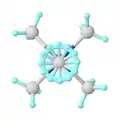Crystallographic disorder
In X-ray crystallography, crystallographic disorder describes the cocrystallization of more than one rotamer, conformer, or isomer where the center of mass of each form is identical or unresolvable. As a consequence of disorder, the crystallographic solution is the sum of the various forms. In many cases, the components of the disorder are equally abundant, and, in other cases, the weighting coefficients for each component differ. Disorder can entail a pair or several components. Disorder usually arises when the forms are nearly equal in energy and the crystal lattice is sufficiently spacious to accommodate the various components.

 One of four rotamers of Mo(CH3)5.
One of four rotamers of Mo(CH3)5.
References
- Beatrice Roessler, Sven Kleinhenza, Konrad Seppelt (2000). "Pentamethylmolybdenum". Chemical Communications (12): 1039–1040. doi:10.1039/b000987n.CS1 maint: uses authors parameter (link)
This article is issued from Wikipedia. The text is licensed under Creative Commons - Attribution - Sharealike. Additional terms may apply for the media files.